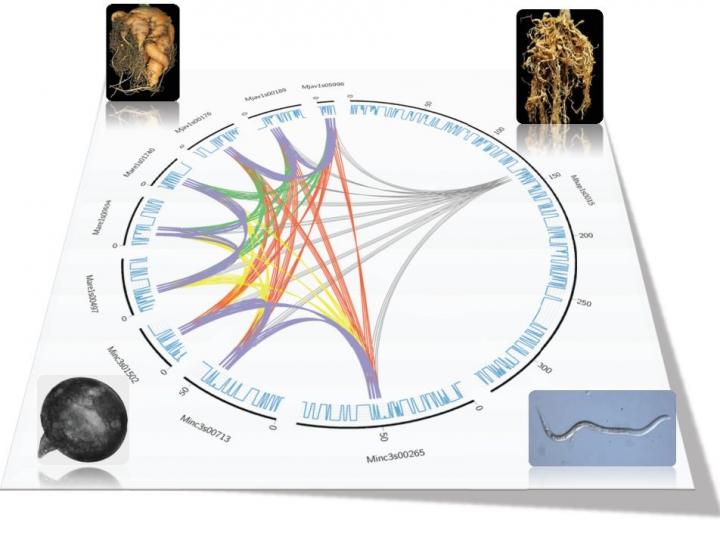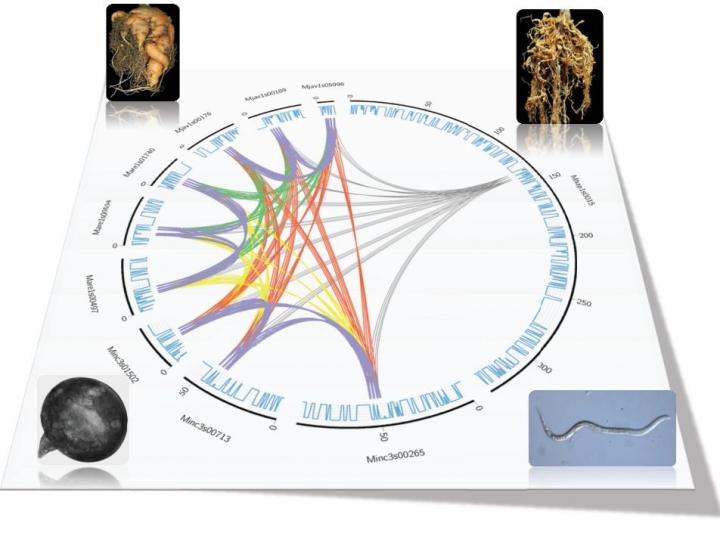
Credit: Etienne G. J. Danchin and colleagues
The nematode worms that cause the world's most devastating crop losses have given up on sexual reproduction and instead rely on their large, duplicated genomes to thrive in new environments. A group led by Etienne G. J. Danchin of the French National Institute for Agricultural Research (INRA) report these findings in a new study published June 8, 2017 in PLOS Genetics.
While most animals – more than 99 percent – find that a sexual lifestyle is the best path for evolutionary success, certain root-knot nematode species can only reproduce without sex. Instead of hitting an evolutionary dead-end, these plant pests have a wider geographic range and can infect greater numbers of crops than sexual species. To investigate the reasons behind their success, researchers sequenced and assembled the genomes of the three most damaging root-knot nematodes and compared them to a sexual relative. The asexual genomes are large, with numerous duplicated regions resulting from past reproduction events where at least two individual genomes recently hybridized together. Further analysis showed that many of the gene copies had each evolved different sequences and functions. Besides these gene copies, the genomes of the asexual nematodes are rich in transposable elements, DNA segments that are able to move and multiply in genomes. These elements could provide genomic plasticity and have functional consequences too. The researchers suspect that the asexual nematodes' unusual hybrid genome structure has helped them to successfully adapt to a wide range of environments, even in the absence of sex.
These findings challenge the prevailing idea that sexual species will always outcompete their asexual relatives and may even have wider implications for our understanding of why sex evolved. The work also supports the existing idea that hybridization is an evolutionary phenomenon capable of giving rise to new parasites and infectious organisms. For plant breeders, a greater understanding of these economically significant parasites can potentially help in the breeding of better plant varieties that can resist nematode attacks and reduce crop losses.
Etienne G. J. Danchin adds: "For a long time, the root-knot nematodes have remained an evolutionary puzzle because the most devastating agricultural parasites are those that have abandoned sex and meiosis. Being unable to combine beneficial mutations from different individuals and unable to purge progressive accumulation of deleterious mutations, they are expected to represent evolutionary dead ends. By analyzing and comparing their genomes, we provide large-scale evidence that these asexual nematodes underwent hybridization and are polyploid. Their duplicated hybrid genome architectures provide these nematodes with multi-copy genes showing diverged sequence and expression patterns where their sexual relatives have very closely related alleles. We suspect these multiple copies provide a reservoir to adapt to different environments and plant hosts, and constitute an evolutionary advantage over their sexual relatives (at least in the short term). Their intriguing parasitic success despite absence of sex could thus be due to their hybrid origin where they combined multiple genomes of adapted parasitic nematodes in one single species.
It is now important to understand how these hybrids have emerged and whether the same conditions could favor emergence of even more aggressive and devastating new hybrids."
###
In your coverage please use this URL to provide access to the freely available article in PLOS Genetics: http://journals.plos.org/plosgenetics/article?id=10.1371/journal.pgen.1006777
Citation: Blanc-Mathieu R, Perfus-Barbeoch L, Aury J-M, Da Rocha M, Gouzy J, Sallet E, et al. (2017) Hybridization and polyploidy enable genomic plasticity without sex in the most devastating plant-parasitic nematodes. PLoS Genet 13(6): e1006777. https://doi.org/10.1371/journal.pgen.1006777
Funding: This work was supported by the Agence Nationale de la Recherche program ANR-13-JSV7-0006 – ASEXEVOL, the INRA program AAP SPE 2011, as well as Université de Nice Sophia-Antipolis Postdoc program 2013-2014. The funders had no role in study design, data collection and analysis, decision to publish, or preparation of the manuscript.
Competing Interests: The authors have declared that no competing interests exist.
Media Contact
Etienne G. J. Danchin
[email protected]
Related Journal Article
http://dx.doi.org/10.1371/journal.pgen.1006777
############
Story Source: Materials provided by Scienmag





